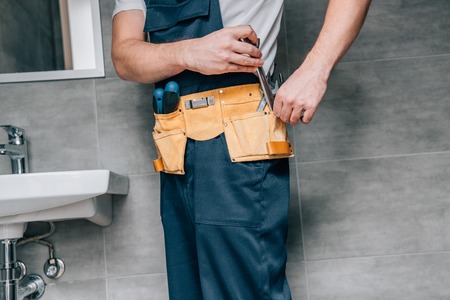Planning Your Plumbing Remodel
Before you start tearing out old pipes or shopping for new fixtures, it’s crucial to lay the groundwork for a successful plumbing remodel. First, take time to understand your existing plumbing layout. Locate main water lines, drains, and vent stacks; this helps prevent unexpected surprises once the renovation begins. Next, set a realistic budget. Plumbing updates can range from straightforward fixture replacements to complex pipe rerouting, so factor in labor costs, materials, and a cushion for unforeseen issues. Lastly, get familiar with your local permit requirements. Many U.S. cities require permits for significant plumbing changes to ensure work meets safety codes. Skipping this step could lead to costly fines or even require you to redo your project. By planning ahead and addressing these essentials, you’ll save yourself headaches—and money—down the road.
2. Selecting Materials and Hiring Professionals
Choosing the right plumbing materials and hiring qualified help are crucial steps in any renovation project. In the United States, the quality of your pipes and fixtures not only affects daily comfort but also impacts your home’s value and safety.
Choosing the Right Pipes and Fixtures
Start by selecting pipe materials that fit your budget and local building codes. Common options include copper, PEX, and PVC. Each has its pros and cons:
| Material | Pros | Cons |
|---|---|---|
| Copper | Durable, long-lasting, resists bacteria growth | More expensive, requires soldering |
| PEX | Flexible, easy to install, cost-effective | Sensitive to UV light, may not be allowed everywhere |
| PVC | Affordable, corrosion-resistant, lightweight | Not suitable for hot water lines, can become brittle with age |
For fixtures like faucets, sinks, and showerheads, look for WaterSense-labeled products to save water without sacrificing performance. Consider finishes and styles that match your aesthetic while keeping durability in mind.
DIY vs. Licensed Plumber: When to Hire a Pro?
Some simple tasks—like replacing a faucet or installing a showerhead—can be handled by handy homeowners. However, complex jobs such as rerouting pipes or working near electrical wiring should always be left to licensed plumbers. U.S. regulations often require a permit and inspection for major plumbing changes.
When You Might DIY:
- Replacing visible fixtures (faucets, showerheads)
- Unclogging drains with basic tools
- Patching small leaks with repair kits
When to Call a Licensed Plumber:
- Moving or adding pipes behind walls or floors
- Installing new supply lines or major appliances (water heater, dishwasher)
- Upgrading main water lines or sewer connections
- If required by local code or insurance policies
How to Hire Reputable Professionals Locally
A good plumber is worth their weight in gold during a renovation. Here’s how to find one you can trust:
- Check Credentials: Ensure they’re licensed and insured in your state.
- Ask for References: Request recent client reviews or references.
- Get Multiple Quotes: Don’t settle for the first estimate—compare at least three.
- Review Contracts Carefully: Make sure all work is detailed in writing before signing.
- Look for Local Experience: Choose professionals familiar with your area’s building codes and climate needs.
Taking time on this step can prevent costly mistakes later—and set you up for a smooth remodel from start to finish.

3. Shutting Off Water and Prepping the Site
Before you start tearing out old pipes or installing new plumbing fixtures, it’s crucial to safely turn off your water supply. Most American homes have a main shut-off valve, usually found in the basement, crawl space, or near where the water line enters your house. Make sure you know its location in advance and test that it works—sometimes older valves get stuck or leak. Once the main valve is closed, open all faucets throughout the house to drain any remaining water from the lines. Don’t forget to flush toilets and run showers until they’re dry; this step reduces pressure and limits surprise leaks when you start working.
Next, take precautions to protect your home from accidental water damage. Lay down heavy-duty tarps or plastic sheeting in work areas, especially if you’re dealing with drywall or flooring that could be ruined by spills. Use buckets and towels around joints you’ll be disconnecting, just in case there’s residual water left in the pipes. If your renovation site is near electrical outlets or appliances, cover them securely and consider shutting off relevant breakers for added safety.
Taking these steps not only helps prevent costly damage but also sets a clean, organized stage for the rest of your remodel. It’s a simple process, but skipping it can lead to major headaches down the road—so don’t rush! Careful preparation here saves time, money, and stress as you move forward with your plumbing renovation.
4. Demolition and Removing Old Plumbing
Once your renovation plans are finalized and the new plumbing layout is mapped out, it’s time to tackle demolition and removal of old plumbing. This step is crucial for ensuring that your upgraded plumbing system will function efficiently and safely. Careful removal of outdated pipes, fixtures, and fittings helps minimize disruption to your home’s structure and surrounding systems. Here’s how you can approach this stage with both precision and safety in mind.
Prepare the Work Area
Before you begin any demolition, protect adjacent rooms and surfaces from dust and debris. Use plastic sheeting to seal off work zones and lay down drop cloths to protect floors. Turn off the main water supply and, if necessary, shut off gas lines connected to water heaters or other appliances.
Systematic Removal Process
Start by disconnecting and removing fixtures such as sinks, toilets, tubs, or showers. Then move on to pipes and fittings, working section by section to prevent accidental damage to walls, floors, or ceilings. If your home has older materials like galvanized steel or cast iron pipes, be prepared for extra effort—they may require special tools or techniques for safe removal.
Common Steps in Plumbing Demolition
| Step | Description | Tips |
|---|---|---|
| 1. Shut Off Utilities | Turn off water and gas lines in the affected area. | Double-check all shut-off valves to avoid leaks. |
| 2. Drain Residual Water | Open faucets at the lowest point to drain remaining water from the pipes. | This helps prevent spills during removal. |
| 3. Remove Fixtures | Disconnect sinks, toilets, tubs, etc., from their supply lines and drains. | Label any reusable parts for later installation. |
| 4. Cut Out Old Pipes | Use a pipe cutter or reciprocating saw to remove old sections of pipe. | Wear gloves and eye protection for safety. |
| 5. Inspect Structure | Check exposed framing, subfloors, and walls for hidden damage or mold. | Address repairs before proceeding with new installation. |
Avoiding Unnecessary Damage
The key during demolition is to disturb as little of the existing structure as possible. Take extra care around electrical wiring, HVAC ducts, or load-bearing walls. If you’re unsure about any part of the process—especially when dealing with older homes where asbestos or lead pipes may be present—it’s wise to consult a licensed professional who can handle hazardous materials safely.
Pro Tip: Plan Disposal Ahead of Time
Arrange for proper disposal of old plumbing materials before you begin work. Many cities in the U.S. have regulations regarding metal recycling or hazardous waste disposal for certain types of pipes. Planning ahead will help keep your project on schedule and compliant with local codes.
5. Installing New Plumbing
After the old plumbing has been safely removed and the layout finalized, it’s time to install your new plumbing system. This phase is crucial—both for functionality and for meeting strict American building codes that govern water efficiency and safety. Start by bringing in updated pipes, which are typically made from PEX or copper in most modern U.S. homes. Make sure each pipe is securely fitted and supported to prevent leaks or future damage.
Next, focus on fixtures like sinks, toilets, bathtubs, and showers. Select EPA WaterSense-labeled products whenever possible; these are specifically designed to conserve water without sacrificing performance—a smart move both for the environment and your utility bills. Carefully connect each fixture according to manufacturer instructions and double-check that every connection is tight and properly sealed.
During installation, pay close attention to local plumbing codes. For example, venting requirements, pipe diameters, and backflow prevention devices are all common code issues in the U.S. If you’re unsure about any aspect of compliance, it’s wise to consult a licensed plumber or local building inspector before proceeding.
Finally, test your new system by running water through each line and checking for leaks or pressure issues. Address any problems immediately to avoid future headaches. Taking the time now to ensure everything is up to code will make inspections smoother—and give you peace of mind that your remodel is built to last.
Inspection and Quality Assurance
Before you start closing up any walls or moving forward with the next phase of your renovation, its crucial to schedule mandatory inspections with your local building department. In the United States, these inspections are not just a formality—they are required by law to ensure that all plumbing work is safe and up to code. Typically, youll need to call your city or countys building office to set up an appointment, and an inspector will come out to review the installation. Its best to plan for this in advance since inspectors can be booked out days or even weeks depending on your area.
Once your inspection is scheduled, make sure all your plumbing lines are accessible and clearly labeled. Inspectors will check for things like proper pipe sizing, secure connections, correct venting, and appropriate use of materials. They will also verify that everything matches the approved plans and complies with local codes. Skipping this step or trying to rush through it can lead to costly delays if your project fails inspection—you might have to open up finished walls or redo work at your own expense.
After the official inspection, do your own quality assurance by testing every connection for leaks. This usually means turning on the water supply and watching closely for drips or moisture around joints and fixtures. Dont forget to flush toilets, run faucets, and test showers as well—catching a leak now is much easier than after everything is sealed up. Double-check that drains empty quickly and there are no unusual sounds that could indicate blockages or improper venting.
Remember, passing inspection isn’t just about meeting legal requirements—it’s about protecting your home from future damage and ensuring everyone’s safety. Taking the time for thorough inspection and quality checks gives you peace of mind before moving on to insulation, drywall, and finishing touches.
7. Final Touches and Clean-Up
With all the plumbing work in place, it’s time to focus on the finishing details that will bring your renovation project together. This phase is all about making your space look complete and ensuring everything is both functional and visually appealing.
Install Finish Fixtures
The first step in this stage is installing finish fixtures such as faucets, showerheads, and handles. These are the elements you’ll use every day, so it’s important they are installed carefully and tested for leaks or issues. Choose fixtures that match your style and budget, and make sure they’re compatible with your new plumbing system. Don’t forget to check for proper water flow and temperature control once everything is hooked up.
Patch Up Drywall and Paint
After installing the fixtures, address any drywall or tile that was removed or damaged during the renovation. Patch holes, sand rough spots, and repaint or retile as needed to restore the room’s appearance. This step helps conceal all the behind-the-scenes work, giving your kitchen or bathroom a seamless look.
Clean the Workspace
The last step is a thorough clean-up. Remove debris, dust, and leftover materials from the workspace to create a polished environment. Wipe down surfaces, polish fixtures, and vacuum or mop floors so the space feels fresh and inviting. Taking pride in these final touches not only ensures homeowner satisfaction but also highlights the professionalism of your renovation process.
Completing these final steps leaves you with a beautiful, fully functional space that’s ready for daily living—making all the hard work worthwhile.


